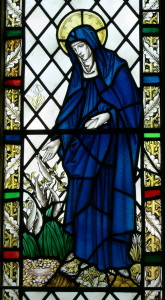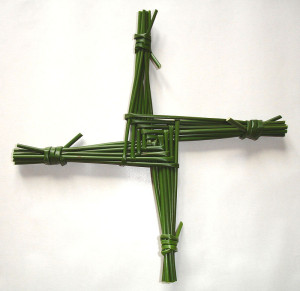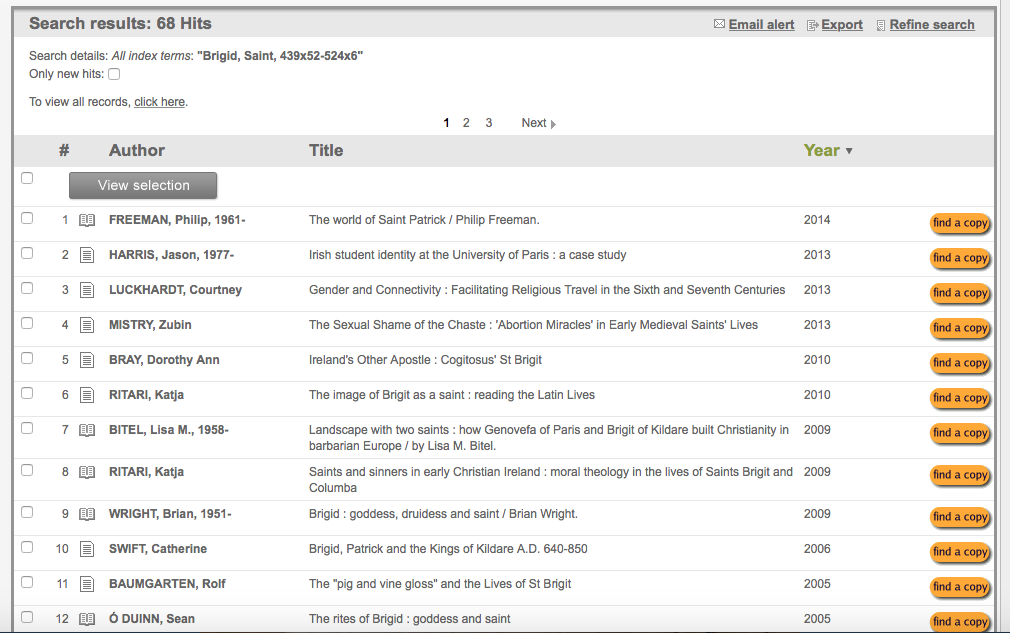The feast day of St Brigid is celebrated on the 1st February, and in honour of this, we have delved into our resources to give a taste of the material available on the Bibliography of British and Irish History.
St Brigid of Kildare is one of the main patron saints of Ireland, along with St Patrick and St Columbus. Brigid was born into slavery in the mid-5th century but became a nun and abbess, founding several monasteries. Her vitae was written by Cogitosus in the 7th century, and is translated in Cogitosus’s Life of St Brigid : content and value. As our range of resources show, the myth of Brigid has associations with an earlier pagan deity of the same name, explored in Brigid : goddess, druidess and saint and Brigit : from goddess to saint. Brigid was also strongly connected with the symbol of fire, as Gerald of Wales recounts in his Topographia Hibernica how the sacred fire of St Brigid burned continually around the monastery at Kildare even after her death, yet never accumulated any ashes. It was tended by the nuns of Kildare for nineteen nights in turn, and on the twentieth night left for Brigid to tend herself. According to Gerald, the scriptorium at Kildare produced an illuminated manuscript so sumptuous it was thought to be the work of angels. Unfortunately this manuscript is now lost, but it would probably have been of a similar quality to the Book of Kells.

Detail from fol. 22r
The image on the right is from London, British Library, Royal MS 13 B VIII, and shows the scribe creating the heavenly manuscript. This copy of the Topographia Hibernica was produced in Lincoln in c. 1196-1208, and most probably was overseen by Gerald himself. The image shows the tools of a scribe, a feather quill (probably goose), and a knife. The knife was used to sharpen the quill and also to correct mistakes, by scraping the ink off the parchment. In this image, it also seems to be used to hold the quill-hand steady and secure the parchment. According to Gerald, the book was composed with the angel presenting the designs, while Brigid prayed, and the scribe copied – ‘sic igitur angelo praesentante, brigida orante, scriptore imitante.’ (fol. 22v).
Like Gerald, Brigid herself was a great traveller, and was the patron saint of travellers and sailors. The network of religious connections she belonged to is further documented in Gender and Connectivity: Facilitating Religious Travel in the Sixth and Seventh Centuries. Miracles associated with Brigid include the themes of farming and generosity, such as when she gave away her freshly churned butter to the needy, only to have it replenished through divine intervention, and the time she milked a cow three times in one day. Dairy themes are expanded further in Milk Symbolism in the Bethu Brigte. More controversially, she is linked with ‘abortion miracles’, explored in The Sexual Shame of the Chaste : ‘Abortion Miracles’ in Early Medieval Saints’ Lives. Iconography associated with Brigid include the reed cross (pictured below), crozier and lamp. She died on 1st February of natural causes, and in the 9th century her relics were interred with the tomb of Patrick and Columba.
To research more about the legend of St Brigid, visit the Bibliography of British and Irish History and use the advanced search feature to explore the many resources:




